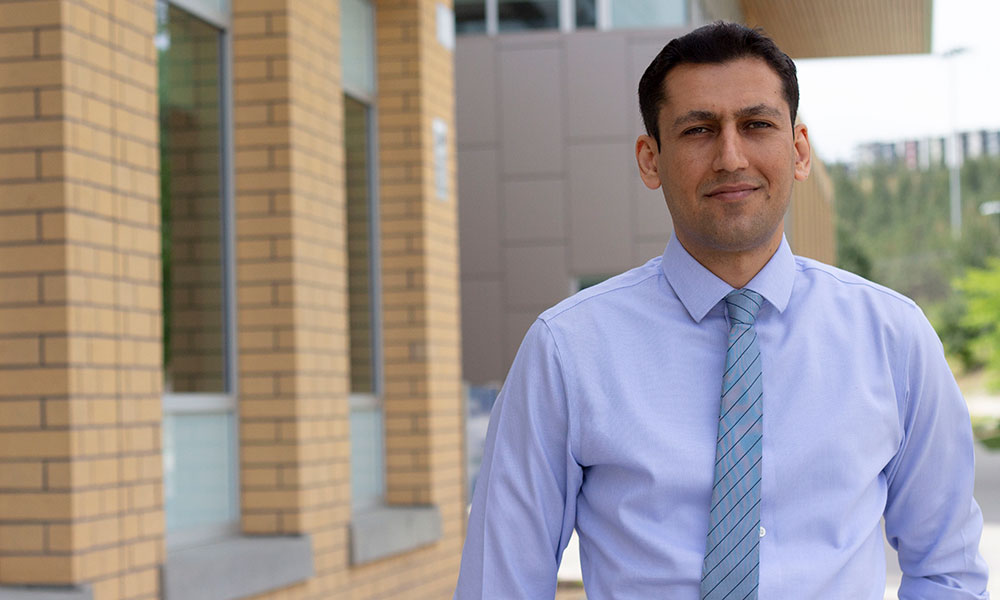Faculty Profile, People
A Marriage of Polymers and Nanotechnology
March 2, 2021

About
Name
Mohammad Arjmand
Role
Assistant Professor
Canada Research Chair in Advanced Materials and Polymer Engineering
Program
School of Engineering
Faculty
Applied Science
Campus
Okanagan (Kelowna, BC)
Education
Postdoctoral Fellowship, University of Toronto
Postdoctoral Fellowship, University of Calgary
PhD, Chemical/Polymer Engineering, University of Calgary
Master of Science, Chemical/Polymer Engineering, Sharif University of Technology
Bachelor of Science, Chemical Engineering, Shiraz University
Hometown
Shiraz, Iran
“What makes polymers so appealing is the infinite possibilities they possess.”
INSIDE THE NANOMATERIALS AND POLYMER NANOCOMPOSITES LAB (NPNL) at UBC Okanagan’s School of Engineering, Assistant Professor Mohammad Arjmand and his team are developing nanoscopic materials aimed at shifting how large-scale materials are manufactured. Whether it’s related to aerospace and electronics or the construction and health-care industries, Dr. Arjmand’s lab has the personnel and equipment to take an idea related to nanomaterials and polymer nanocomposites and develop it into an end product.
Find out more about Engineering
The word polymer is derived from the Greek ‘poly,’ meaning many or much, and ‘meros,’ meaning part. Often associated with plastics or rubbers, polymers are attractive to manufacturers and materials scientists because they provide a lighter and cheaper alternative to ceramics and metals. When mixed with multifunctional nanomaterials — which are highly-functional materials with modified properties — they come with the added benefit of enhanced mechanical, thermal and electrical properties, to name a few.
“What makes polymers so appealing is the infinite possibilities they possess,” explains Dr. Arjmand, who holds a Canada Research Chair (Tier 2 – NSERC) in Advanced Materials and Polymer Engineering.
As industry shifts to using more polymers for advanced applications, Dr. Arjmand and his team continue to develop multifunctional nanomaterials and mix them with polymers to develop multifunctional polymer nanocomposites with a desired structure and property.
One such example of the lab’s work is the development of multifunctional polymer nanocomposite filaments for use in the 3D printing industry. Common commercial 3D printing filaments are made of pure polymers, which lack the required physical properties for advanced applications. But, the 3D printing filaments developed in Dr. Arjmand’s lab are polymer nanocomposites as opposed to virgin polymers, meaning they inherently have outstanding physical properties. The development of such filaments allows scientists to develop advanced materials with complex geometries, which can then be used in high-tech industries.
To put Dr. Arjmand’s work in perspective, some of the nanoscale materials developed in the NPNL have a dimension of 1/1000 of a human hair but can possess superior physical properties to even the strongest metals.
Since these materials can be designed to have electrical and thermal conductivity as well as mechanical strength, they are ideal for use in sectors like automotive, aerospace, information technology and health care.
The diverse and interdisciplinary nature of Dr. Arjmand’s research has also resulted in collaborations with a variety of researchers from different disciplines, including biology, forestry, chemistry and engineering. He has collaborators across the world, including Canada, the United States, Germany, India, Brazil, South Korea, France and Iran.
In one such partnership, Dr. Arjmand collaborated with researchers from Sharif University in Iran and the University of Toronto to design brakes that self-lubricate. Instead of using traditional brake pad materials that are metal, ceramic or organic, the researchers developed a composite polymer brake pad that performed better than traditional materials in the areas of cost, durability, response time, temperature and noise.
“Our findings demonstrate that the newly-designed carbon fibre polymer brakes represent an acceleration in the science of deceleration and could be a real boon for the industry and consumers alike,” says Dr. Arjmand. “No researcher in Canada is currently working in this area, and the work is very important for the automotive and railroad industries.”
Other projects on the go at the NPNL include developing polymer-based electromagnetic shields, explorations into wastewater treatment, converting recycled plastics into value-added polymer nanocomposites, developing advanced gas sensors, researching compostable bio-based nanocomposites for the food industry, creating smart face-shields to protect against COVID-19, and developing advanced materials for ballistic protection.
As for the future, Dr. Arjmand sees plenty of opportunities to further integrate and use nanoscale materials and nanocomposites: “It’s exciting to explore the potential uses of these impressive materials and help various industries evolve.”